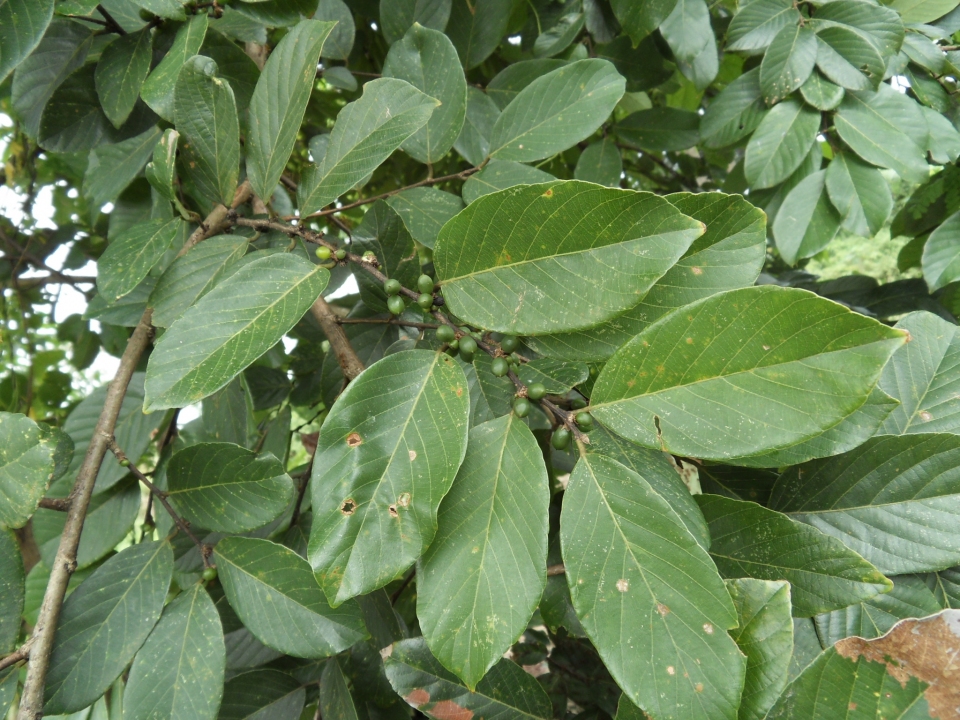Bridelia ferruginea.

|
|
Bridelia ferruginea Common Names: Bridelia, Ironwood, Rusty Bridelia Scientific
Classification Kingdom: Plantae Phylum: Tracheophyta Class: Magnoliopsida Order: Malpighiales Family: Phyllanthaceae Genus: Bridelia Species: B. ferruginea Synonyms: Bridelia micrantha var. ferruginea (Benth.) Müll.Arg., Bridelia speciosa var. kourousensis Beille, Gentilia chevalieri Beille Morphological Description Bridelia ferruginea, commonly known as Bridelia or Rusty Bridelia, is a deciduous
tree or shrub, typically growing 5–25 m tall, with a dense, rounded crown up to
10 m wide. Its key features include: · Bark: Grey to brownish-grey, rough, scaly, often with vertical
fissures, exuding a red sap when cut · Leaves: Simple, alternate, elliptic to obovate, 5–15 cm long, 3–8 cm
wide, leathery, glossy green above, densely rusty-pubescent beneath · Flowers: Small, greenish-yellow, 2–4 mm in diameter, in axillary or
terminal clusters, monoecious · Fruit: Ellipsoid drupe, 5–8 mm long, green turning black, with a
single seed The rusty appearance of
the leaf undersides, due to dense hairs, gives the plant its name
"ferruginea" (Latin for rusty). Distribution and Habitat Bridelia ferruginea is native to tropical and subtropical Africa, spanning West
Africa (Senegal, Nigeria) to Central Africa (Democratic Republic of Congo) and
parts of East Africa (Uganda, Tanzania). It thrives in: · Ecosystems: Forest margins, savannas, woodlands, riverine forests, and
secondary growth areas · Climate: Tropical to subtropical, with rainfall of 800–2,500 mm
annually and temperatures of 20–35°C · Soils: Well-drained, loamy to sandy, tolerating nutrient-poor
conditions · Altitude: Sea level to 1,500 m In Nigeria, it is common
in southern rainforests and northern savannas, often along riverbanks and in
disturbed areas. Ethnopharmacology Bridelia ferruginea , commonly known as Bridelia or blackbird tree, is a highly
valued medicinal plant in African traditional medicine. Various parts of the
plant—particularly the bark, leaves, and roots—are used for their
antimicrobial, anti-inflammatory, antidiabetic, antioxidant, analgesic, and astringent
properties. Traditionally, decoctions made from the bark or leaves are used to
treat diarrhea, dysentery, fevers, malaria, skin infections, rheumatism, and
wound healing. It is also employed in managing hypertension, diabetes, and
respiratory ailments like coughs and bronchitis. Phytochemical studies have
shown that Bridelia ferruginea contains flavonoids, alkaloids, tannins,
saponins, and phenolic compounds, which contribute to its wide range of
therapeutic effects. Although traditional use is widespread and promising,
further pharmacological research and clinical trials are needed to confirm its
efficacy and establish safe medicinal standards. · Anti-inflammatory
and Analgesic Activities:
The aqueous stem bark extract of Bridelia ferruginea exhibits significant
anti-inflammatory effects by inhibiting carrageenan-induced paw edema and
granuloma formation in rodents. It also stabilizes erythrocyte membranes and
reduces vascular permeability. Analgesic properties have been observed in
models of pain and inflammation (Anikwe, 2016; Olajide et al., 2000). · Antimicrobial
Activity: Methanol, ethyl
acetate, and hexane extracts of the leaves have demonstrated antimicrobial
activity against various pathogens, including Pseudomonas frutescens, Bacillus
subtilis, and Escherichia coli (Talla et al., 2002). · Antioxidant
Properties: Methanolic extracts of
the stem bark possess potent antioxidant activity, effectively scavenging free
radicals and inhibiting lipid peroxidation. These properties are attributed to
the presence of phenolic compounds (Mahomoodally et al., 2021). · Antidiabetic
Effects: Ethyl acetate and
acetone fractions of the plant have been shown to improve insulin sensitivity
in fructose-induced insulin-resistant mice, suggesting potential antidiabetic
properties (Green Institute, n.d.). · Antineuroinflammatory
Activity: The extract inhibits
neuroinflammation by modulating p38 MAPK and NF-κB signaling pathways,
indicating potential therapeutic applications in neuroinflammatory conditions
(Olajide et al., 2012). · Anticancer Potential: Methanolic
leaf extracts inhibited human colon cancer cells (HCT116) proliferation,
attributed to quercetin and corilagin, supporting
potential cancer treatment (Mahomoodally et al., 2021;). ⚠ Toxicity Profile: Bridelia ferruginea has low acute oral toxicity (LD₅₀
>4,000 mg/kg in rodents), with no significant changes in hematological or
biochemical parameters at 250–1,000 mg/kg. However, sub-chronic use at 600
mg/kg caused mild liver damage and increased lipid peroxidation in rats.
Aqueous stem bark extracts showed an LC₅₀ of 139.09–199.72 mg/L in fish (Clarias gariepinus), indicating aquatic toxicity. High doses
reduced sperm count in rats, suggesting reproductive toxicity. The root sap’s
use as a fish poison indicates bioactive compounds like tannins, which may
cause pyelonephritis in rats at 2.5% w/v in wastewater. Traditional
preparations (e.g., boiling) reduce risks, but excessive or prolonged use,
especially of roots, should be avoided (Awodele
et al., 2015; Kolawole et al., 2009; Ikechukwu et al., 2015;). Additional Uses · Culinary and Beverage Enhancement: Bark is added to palm wine in Nigeria to
enhance potency and flavor. · Timber and Fuel: The hard, durable wood is used for
granaries, tool handles, and fuelwood in Nigeria and Ghana. · Cultural and Ritual: Considered sacred in southern Nigeria,
used in rituals for healing and purification. · Dyeing and Crafts: Leaf and bark extracts are used for dyeing
textiles and glazing pottery in West Africa (Lemmens, 2013). · Ecological Role: As a pioneer species, it stabilizes soils
in disturbed areas and supports agroforestry systems in Nigeria References
External Links More Pictures |
|
| Compounds of Bridelia ferruginea. | |
| References |